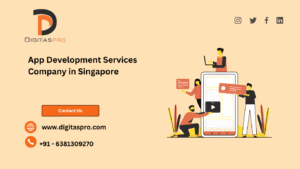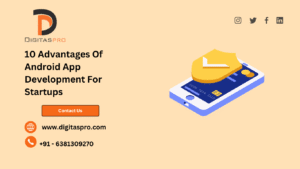In a world where mobile users outnumber desktop users and consumer attention spans are short, a well-designed app can be your biggest business asset. In 2025, app development is more agile, design-centric, and user-driven than ever before. If you’re wondering how to create an app, you’re in the right place.
At DigitasPro Technologies, we help businesses across industries bring their app ideas to life. This guide breaks down the entire process into 12 clear, actionable steps.
Step 1: Define Your Idea and Purpose
Every great app starts with a strong idea. Begin by identifying the problem your app will solve.
Key Questions:
- What is the core purpose of the app?
- Who is the target audience?
- How does it add value to users?
Start with a simple problem-solution statement. This helps shape your direction and makes pitching to investors easier.
Example: “An app that connects pet owners with certified veterinary professionals for instant consultations.”
Step 2: Conduct Market Research
Validating your idea is crucial before diving into development.
What to research:
- Competitor apps and their user reviews
- Market demand and trends
- App monetization opportunities
Tools: Google Trends, Statista, SensorTower, App Annie
Pro Tip: Build a user persona to visualize your ideal customer. Include demographics, pain points, and behavior patterns.
Step 3: Sketch Out Key Features (MVP Planning)
You don’t need to build every feature at once. Start with your MVP – Minimum Viable Product.
Focus on:
- Must-have features (user login, dashboard, notifications)
- Features that solve the core problem
- Scalable architecture
Prioritize using the MoSCoW method (Must have, Should have, Could have, Won’t have).
Step 4: Choose the Right Tech Stack
Your app’s performance depends heavily on your choice of technology.
Decide on:
- Platform: iOS, Android, Web, or Cross-platform
- Frameworks: React Native, Flutter, Swift, Kotlin
- Backend: Node.js, Laravel, Firebase
Need help choosing? DigitasPro’s tech team can assess your project and suggest the best tech stack for performance and cost.
Step 5: Build Wireframes & UX Flow
Think of wireframes as the blueprint of your app. They give a visual structure to your app’s flow.
Best Practices:
- Keep user navigation intuitive
- Map out each screen transition
- Ensure accessibility compliance
Tools: Figma, Adobe XD, Sketch
Step 6: Design UI/UX Interfaces
First impressions matter. In 2025, app users demand visually pleasing and responsive designs.
Design Tips:
- Use a consistent color scheme and font family
- Follow mobile design guidelines (Material Design, Human Interface)
- Use micro-interactions for better feedback
Trends for 2025: Glassmorphism, Dark Mode, Animated Icons
Step 7: Develop the App (Frontend + Backend)
This is where your app starts taking shape.
Frontend Development: Visuals, layouts, animations, responsive UI Backend Development: Databases, APIs, authentication, logic
Use agile sprints and CI/CD (Continuous Integration/Continuous Deployment) to streamline development.
Pro Tip: At DigitasPro, we provide clients with weekly development updates and working prototypes.
Step 8: Test the App Rigorously
Testing ensures the app works under all conditions. It’s an essential step that shouldn’t be skipped.
Types of Testing:
- Functional Testing
- Usability Testing
- Security Testing
- Device Compatibility
Tools: Appium, TestRail, Firebase Test Lab
Tip: Test on multiple real devices, not just emulators.
Step 9: Launch a Beta Version
Launching a beta allows you to gather feedback from real users.
Why it matters:
- Helps detect bugs missed in QA
- Gathers insights on user behavior
- Creates buzz and early adopters
Platforms: TestFlight for iOS, Google Play Console for Android
Tip: Offer incentives for beta testers like gift cards or free subscriptions.
Step 10: Submit and Launch Your App
Once beta testing is complete and feedback is integrated, it’s time to go live.
What to prepare:
- App screenshots and promotional videos
- App descriptions (with keywords)
- Privacy policy and compliance certificates
Note: App Store (Apple) has a stricter review process compared to Google Play. Plan for delays.
Step 11: Market Your App Smartly
Marketing is key to your app’s success.
Strategies to Use:
- App Store Optimization (ASO)
- Paid Ads (Google, Meta, TikTok)
- Social Media Promotions
- Influencer Partnerships
- PR & Blog Outreach
Pro Tip: Use DigitasPro’s digital marketing team for integrated app promotion campaigns.
Step 12: Maintain, Update, and Scale
Your app launch is just the beginning.
Post-launch tasks:
- Monitor performance with analytics (Firebase, Mixpanel)
- Fix bugs and respond to user feedback
- Release updates regularly
Scaling Tips:
- Add new features based on user requests
- Explore app monetization: ads, subscriptions, freemium
Why Choose DigitasPro Technologies?
At DigitasPro Technologies, we provide end-to-end mobile app development services — from idea validation to app store launch and beyond. With a user-centric approach and a team of experienced developers, designers, and marketers, we make app creation a smooth and scalable process.
Industries We Serve:
- eCommerce
- Healthcare
- EdTech
- Logistics
- Travel & Hospitality
Our Expertise:
- Cross-platform App Development
- UI/UX Design
- API Integrations
- Cloud Backend Solutions
- Agile Project Management
Let’s Build Something Great
Whether you’re a startup founder, enterprise leader, or an innovator with an idea, we’re ready to help you turn your vision into a fully functional mobile app in 2025.
📩 Contact Us Today for a Free Consultation.
🌐 Website: www.digitaspro.com
📧 Email: ping@digitaspro.com
📞 Phone: +91-6381309270


